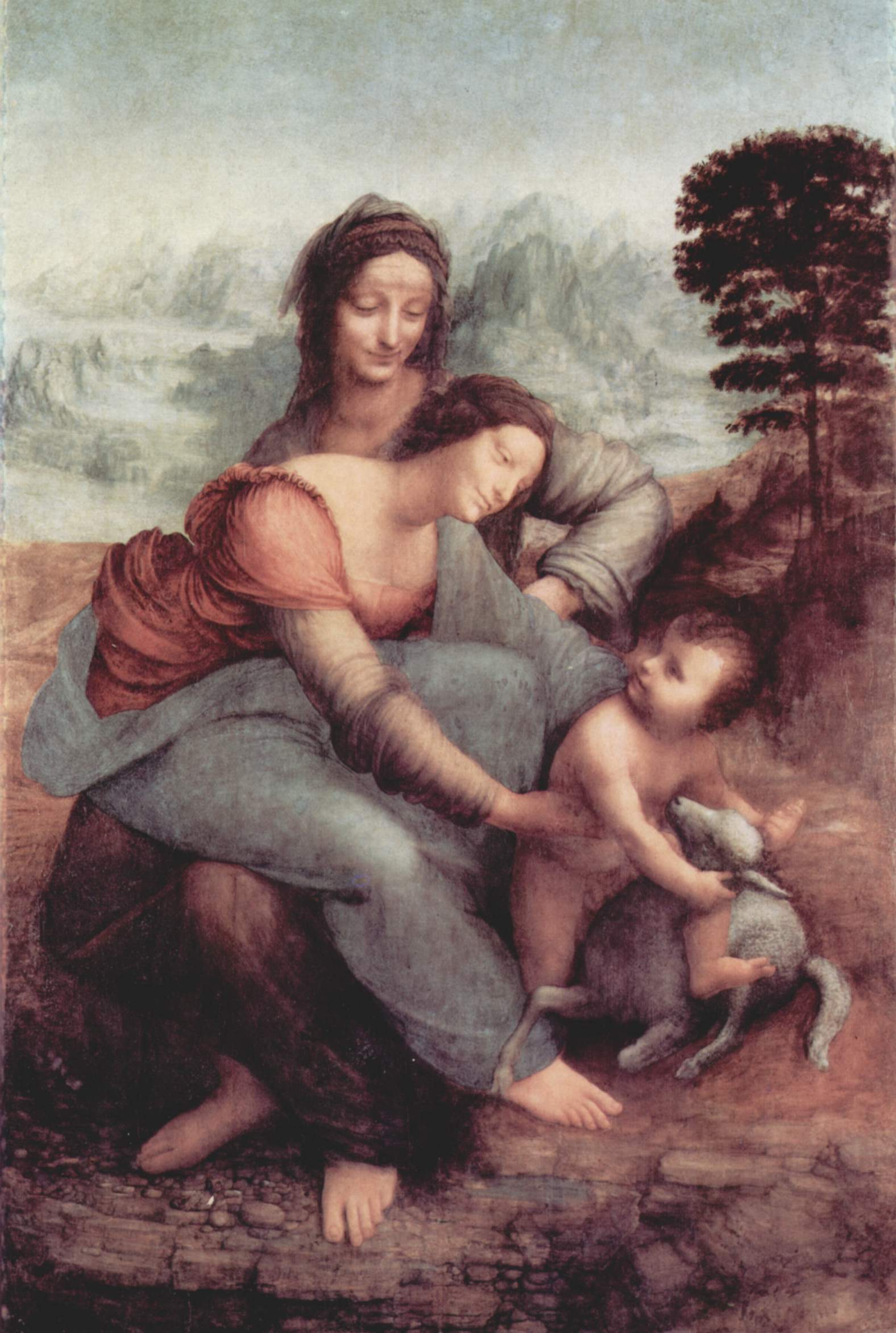- The Virgin and Child with St. Anne
title=The Virgin and Child with St Anne
artist=Leonardo da Vinci
year=circa1508
type=Oil on wood
height=168
width=112
city=Paris
museum=Louvre "The Virgin and Child with St Anne" is an
oil painting byLeonardo da Vinci depicting St. Anne, her daughterthe Virgin Mary and the infant Jesus. Christ is shown grappling with a sacrificial lamb symbolising his Passion whilst the Virgin tries to restrain him. The painting was commissioned as the high altarpiece for the Church of Santissima Annunziata inFlorence and its theme had long preoccupied Leonardo.History
In
1498 , Leonardo probed into incorporating these figures together by drawing the Burlington House Cartoon (National Gallery,London ), which included all three figures in addition to an infant St John the Baptist. An earlier cartoon exhibited in Santissima Annunziata in1501 is now lost.Ultimately, this painting would emerge during the later years of his life, when he was occupied with an interest in mathematics and other pursuits, its rocky landscape betraying his interest in
geology . The demands of his other interests may have forced him to leave this painting incomplete.In addition to the symbolism of Christ playing with the lamb discussed above, Fra Pietro da Novellara, a Vice General of the
Carmelite Order , saw a further layer of symbolic significance to the painting. He believed that St Anne's serene expression, in contrast with Mary's anxiety for her child, "perhaps stands for the Church that does not want to have the Passion of Christ prevented".The painting's pyramidal structure influenced
Raphael andAndrea del Sarto . Its composition inspired two HighRenaissance sculptures, one byAndrea Sansovino (S. Agostino,Rome ) and another, less successful work byFrancesco da Sangallo (Orsanmichele , Florence).Freud's interpretation
Sigmund Freud undertook a psychoanalytic examination of Leonardo in his essay "Leonardo da Vinci, A Memory of His Childhood ". According to Freud, the Virgin's garment reveals avulture when viewed sideways. Freud claimed that this was a manifestation of a "passive homosexual" childhood fantasy that Leonardo wrote about in theCodex Atlanticus , in which he recounts being attacked as an infant in his crib by the tail of a vulture. He translated the passage thus::"It seems that I was always destined to be so deeply concerned with vultures—for I recall as one of my very earliest memories that while I was in my cradle a vulture came down to me, and opened my mouth with its tail, and struck me many times with its tail against my lips."
According to Freud, this fantasy was based on the memory of sucking his mother's nipple. He backed up his claim with the fact that Egyptian hieroglyphs represent the mother as a vulture, because the Egyptians believed that there are no male vultures and that the females of the species are impregnated by the wind.
Unfortunately for Freud, the word 'vulture' was a mistranslation by the German translator of the Codex and the bird that Leonardo imagined was in fact a kite. This disappointed Freud because, as he confessed to
Lou Andreas-Salomé , he regarded "Leonardo" as 'the only beautiful thing I have ever written'. Some Freudian scholars have, however, made attempts to repair the theory by incorporating the kite.Another theory proposed by Freud attempts to explain Leonardo's fondness of depicting the Virgin Mary with St Anne. Leonardo, who was illegitimate, was raised by his blood mother initially before being 'adopted' by the wife of his father Ser Piero. The idea of depicting the Mother of God with her own mother was therefore particularly close to Leonardo's heart, because he, in a sense, had 'two mothers' himself. It is worth noting that in both versions of the composition (the Louvre painting and the London cartoon) it is hard to discern whether St Anne is a full generation older than Mary.
Gallery
See also
*
The Virgin and Child with St Anne and St John the Baptist References
* [http://www.clas.ufl.edu/ipsa/2003/Greenw.html Freud, The Writer of "Leonardo"]
Wikimedia Foundation. 2010.

